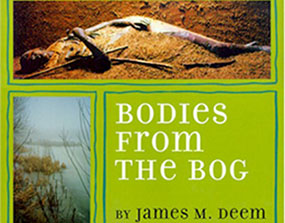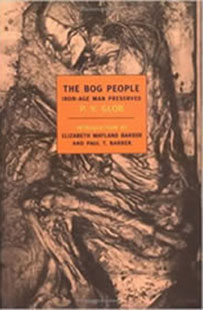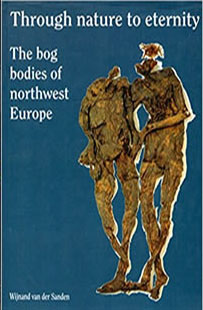Paperback edition, 2003.
|
~~ Suggestions for Visiting Bogs and Bog Bodies ~~ ~~ Bog Body Stories ~~ Related Books by James M Deem: Bodies from the Ice ~~ Bodies from the Ash ~~ ~~ |
Lindow Man
The Discovery
Maybe Andy Mould had a special knack that most people don't have. Or maybe it was just a coincidence. But in 1983 and then again in 1984, he found human remains in an English peat bog known as Lindow Moss. The first time, he had found the head (mostly a skull with little skin or brain remaining) of a woman.
A year later, on August 1, 1984, he was working with Eddie Slack, placing blocks of peat onto an elevator that would transport them to a shredding mill, when he looked at one block of peat and noticed what he thought was a piece of wood embedded in it. He threw it toward Eddie but it struck the ground and crumbled, revealing a human foot. Without hesitation, Andy reported his disturbing find, and shortly the police arrived. With Andy and Eddie's help, they located the area of the bog where the foot had been found. There, on the surface, was a flap of darkened skin belonging to what was later called Lindow Man. They covered it with wet peat until scientists could be summoned to view the body.
Five days later, in the presence of several paleobotanists and a biologist, the block of peat containing Lindow Man was cut, placed on a sheet of plywood, and transported to a local hospital. There, the authorities attempted to date the remains. After all, no one knew if Lindow Man was a recent murder victim or a man from the past.
As it turned out, Lindow Man had died between A.D. 50 and A.D. 100. The scientists learned, when the body was examined, that the man had been murdered. They determined this by examining his body visually and then inspecting x-rays of it. At the same time, they tried to create an image of Lindow Man's appearance. Then they looked inside - especially at his stomach - to find more clues to the mystery of his death.
Step 1: Examining Lindow Man Visually
A close visual examination provided obvious clues that Lindow Man had been murdered.
Head and neck. First, he had been hit twice on the crown of his head with a blunt object, probably an ax; he had also been struck once at the base of his skull. Second, he had been strangled. Around Lindow Man's neck was a small rope that had been twisted tightly, closing off his windpipe and breaking two of his neck vertebrae. Finally, scientists found a gash at the throat, which may indicate that his throat was cut, though some scientists think that the wound occurred naturally after his death. If indeed his throat was cut, it was probably done to drain his body of blood.
Hair. Scientists discovered some interesting details by looking at Lindow Man's hair and beard. They were surprised that he had a beard, since no other male bog body had been found with a beard; this was clearly not common at the time he lived. Scientists also learned that someone had trimmed Lindow Man's hair with scissors two or three days before his death. Historians and archaeologists knew that, although scissors existed in England at the time, they would have been uncommon, most likely reserved for a privileged few. Was the murdered man, they wondered, a dignitary?
Fingernails. Scientists found that his fingernails appeared well-manicured and cared for. They wondered if this showed that he was an important member of society, who was exempt from manual labor. But as Don Brothwell, who studied Lindow Man, explained, no one really knows what the manicured fingernails of a bog person would look like, since no one has ever compared the fingernails of mummies.
Clothing. Unfortunately, Lindow Man was naked, except for an arm band made of fox fur and the thin rope around his neck. Without clothes, he could have been a king or a laborer. As author Brothwell put it:
Why did he have a well-developed, but roughly trimmed, beard - unique among bog bodies - and well-kept nails? Was he an aristocrat fallen on hard times, or a high-born prisoner sacrificed to the gods?
Step 2: Reconstructing Lindow Man
The next step pursued was the reconstruction of Lindow Man. What did he look like? How tall was he? What was his body build? Because his body was rather flattened and his face squashed by the layers of heavy peat bog pressing against the body, scientists wanted to get a more realistic picture of the 2,000-year-old man.
Height. Forensic anthropologists and other scientists can use the length of a person's leg bones (the femur and tibia) to provide an estimate of his height. Remember, though, that Lindow Man's legs had not been recovered with the body. The scientists had to use another technique which relied on the humerus (or upper arm bone). In this way, they determined that Lindow Man was about five feet seven inches tall, probably a little taller than most men in his realm.
Body build. The team of scientists noted that, judging from the outside anyway, Lindow Man was well-built and clearly in his prime.
Step 3: Exploring Lindow Man's Stomach
When the scientists explored Lindow Man's interior cavity, looking for any signs of disease, they were pleased to find that his stomach had not decayed. It contained something like brown mud, the remnants of the last meal he had eaten. Because they found only twenty grams of partially digested food, the scientists concluded that Lindow Man's last meal was really more of a snack. It consisted mostly of cereal grains, but something that he ate was burnt. They wondered, was it bread or gruel? Although no one can be certain, they believe that his meal consisted in part of some charred bread (though he could have had some scorched gruel, too).
They also found evidence of pollen from a mistletoe plant in his stomach. If it came from a flower, this would allow scientists to place his death in March or April. If it was dried pollen, added as an ingredient to his dinner, then the time of his death is harder to place.
Archaeologist Anne Ross thinks she knows what happened to Lindow Man. When the Romans invaded Britain, they conquered the local tribes of Celts and wrote a number of accounts describing Celtic ceremonies and practices, many of which struck them as barbaric. In one festival, called Beltain, which was held on May 1, a victim was selected for sacrifice to make sure that the summer's crops would be successful.
Here's how historians believe the festival was celebrated: a bonfire was lit on top of a hill. In it, an oatmeal cake, called a bannock, was baked and a small portion of it charred. The bannock was then broken into small pieces and put in a bag. The person who chose the burnt piece of bannock became the sacrificial victim. Ross believes that Lindow Man was a Beltain sacrifice.
Historians, though, have pointed out that the victim selected during Beltain was almost always burned in the bonfire. So how, if Lindow Man was a Beltain victim, did he escape the fire and find his way to the bog?
According to Ross, the Celts considered the number three holy. They had three gods: Taranis, the god of thunder; Esus, the god of the underworld; and Teutates, the god of the tribe. Each required a specific type of sacrifice. Ross explains:
Taranis required prisoners of war to be burnt alive in giant wicker cages, while Esus was offered victims who were either hanged from sacred trees or stabbed to death or both. Teutates, however, took his sacrifices into a watery embrace in the sacred wells and pools that always figured very strongly among Celtic holy sites.
Instead of sacrificing three individuals, the Celts sometimes sacrificed one person to please all three gods. This could have been the case with Lindow Man. First, he was sacrificed to Taranis. Although normally involving fire, sacrifices to Taranis were also made with the use of a weapon. In the case of Lindow Man, the three blows to his skull, writes Ross, were "delivered with the sudden awful force of a thunderbolt, the mark of Taranis." Second, he was sacrificed to Esus when he was strangled and his throat cut. Third, he was sacrificed to Teutates when he was placed in the bog and drowned.
But who was Lindow Man, and why was he sacrificed in such an elaborate ceremony?
Although victims might have been sacrificed occasionally, they were not usually killed the way Lindow Man was. Had it simply been the bad luck of selecting the charred piece of bannock?
Or was more involved?
Ross concludes that he was either a Celtic priest, otherwise known as a Druid, or a king. Because his hands were free from calluses and his body had not previously been injured, he was neither a laborer nor a warrior. He was clearly an important man - not the type of person routinely sacrificed.
Ross guesses that the invasion of the Romans in A.D. 43 may have caused the Celts to take the dramatic step of sacrificing an extremely important individual in their attempt to appease the gods and thwart the Romans. In fact, she goes so far as to place his death in A.D. 60, after the Romans had attempted to wipe out all traces of the Celts and the Druids. She believes that Lindow Man may even have chosen to die himself in order "to stave off the Roman threat." Whether or not Ross's speculations are correct, they provide an interesting theory. They also show how much - and how little - scientists can learn from a mummy's tummy.

Copyright © James M. Deem. Originally published in How to Make a Mummy Talk (Houghton Mifflin, 1995). All rights reserved.





